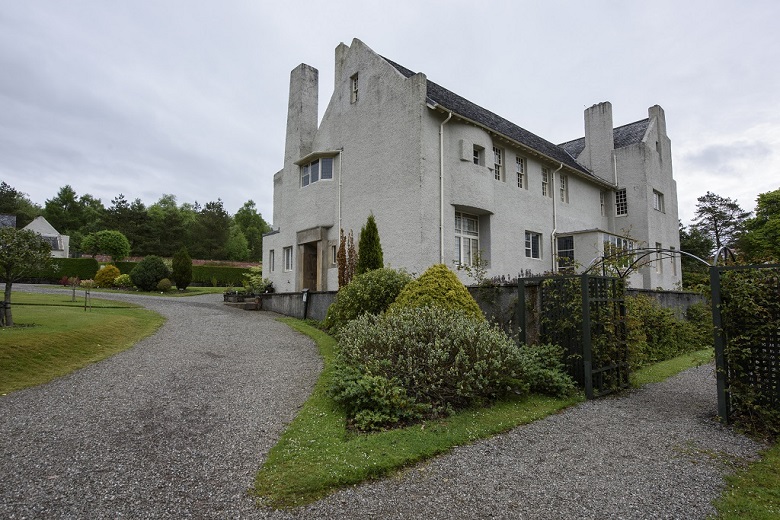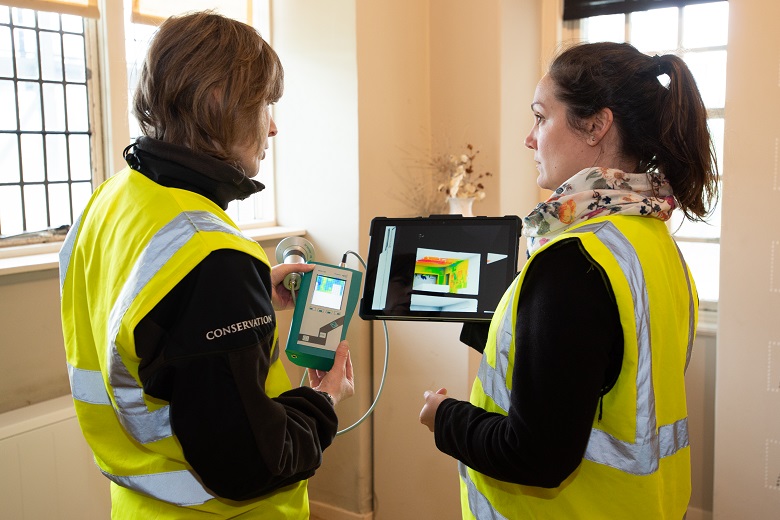Follow along with the Conservation Science and Digital Innovation teams as they undertake a busy day of fieldwork at Hill House, designed and built by Charles Rennie Mackintosh in the early 20th Century and currently in the care of the National Trust for Scotland.
The team consists of HES Conservation Scientists, Aurélie, Sarah, Callum, and Maureen, and Sophia, the Digital Project Officer for the Hill House, jointly employed by NTS.

The Hill House prior to the erection of the “Hill House Box” (A. Frost 2018)
An Early Start
The team arrives in Helensburgh bright and early, before visitors have access to the house. Even at this time, the house is abuzz with the quiet activity of staff dusting off books in the library, opening blinds in the living room and gently hoovering carpets in the hall.
On this particular day of fieldwork, they’ll undertake the second phase of a scientific survey to monitor the amount of damp in the walls. The building is drying out following the installation of the “Hill House Box” – a protective steel frame structure designed to protect the house from rain.
Moisture Monitoring
Adding to the usual morning hum, Aurélie, Callum and Sarah are carefully measuring out a grid on the floor alongside the window of a first floor bedroom with small wooden markers.
The markers on the ground will be used to undertake a microwave moisture survey of the walls. This is a non-destructive method of measuring moisture content up to 30cm deep.

The survey is simple to carry out. The kit looks almost like an oversized stethoscope at the doctor’s office. It is attached to a small handheld screen.
To take a measurement, simply hold the sensor against the wall (just like a doctor looking for a heartbeat!). Press ‘enter’ three times to take three readings.
The kit takes the average of those readings for its final measurement of the point. The process is very quick, a single measurement taking mere seconds.

Sarah Hamilton and Callum Graham (above) carrying out the microwave moisture monitor survey
It’s then a matter of moving methodically up, down, and across the wall following the grid. Simple, right?
Well, mostly. The real trick is to make sure that you don’t get too complacent and miscount. This would result in accidental gaps in the data and an exasperated retracing of steps.
Thermal Snaps
Outside on the walkways, Maureen is using another strategy to assess the damp in the building.
Armed with a thermal camera, she is able to take readings of the infrared radiation of the surface of the building. This offers clues as to where moisture may be located, and how it moves throughout the building.

Maureen Young taking thermal imaging of the exterior of the house
A Virtual Tour
Meanwhile, back inside the house, Sophia is making her way through the property with an odd-looking companion on a tripod.
This piece of kit (christened Delores) is a 360 camera, controlled through an app. The images taken with it will be used to create a virtual 360 tour of the house.
The key thing to remember when taking 360 photography is finding a place to hide before taking the shot! If you can see Delores, she can see you!

Sophia Mirashrafi taking 360 photography of the Living Room for the virtual tour
Collaboration: The Future of Hill House
Believe it or not, all of these moving parts come together at the end of the day.
Combining digital and scientific data is an enormously effective way of visualising and interpreting how moisture is held throughout the building. By uniting the data gathered by our teams, we are able to visualise the invisible damp beneath the walls in 3D space.

Sarah Hamilton (left) and Aurélie Turmel utilising the 3D data to discuss how damp is held in the building
The digital documentation and scientific investigation of the Hill House is only one step in the conservation of the building.
Now that the house is safely within its protective box, experts can compile and use the data gathered by these teams to decide how to move forward.
To learn more about the first phase of the survey taken in 2018, have a read of our previous blog from Hill House.
Blog authors: Aurélie Turmel and Sophia Mirashrafi

